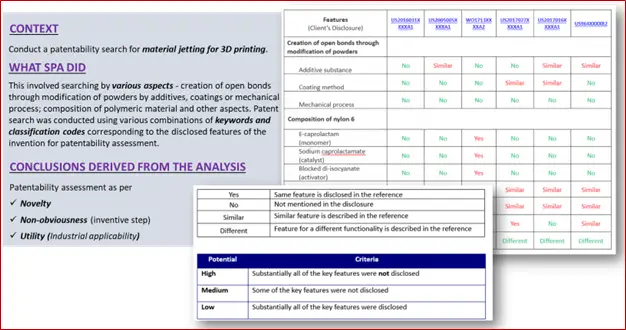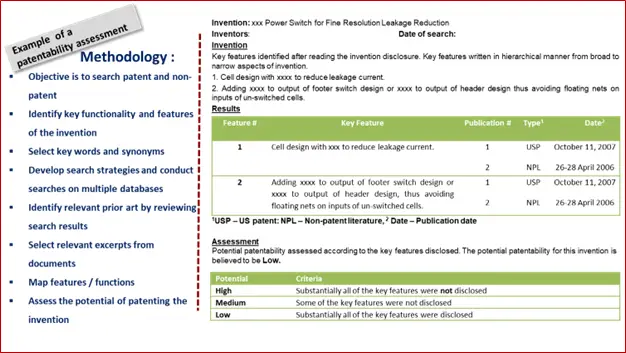Patentability An Introduction:
“Patentability” refers to the substantive conditions that must be met, for an invention, to be patented. The invention must satisfy the requirements under the context of a national or international patent system. An invention is patentable if it meets the related legal conditions to be granted a patent.
The invention must meet the following patentability requirements:
- The invention must be a patentable subject matter. Patent systems worldwide have a list of patentable and unpatentable subject matter. Therefore, the invention must exist in the list of patentable subject matter.
- The invention must be novel. It must not be already known to the public anywhere in the world.
- The invention must not be obvious to the person skilled in the art, i.e. the invention must be different from what a person skilled in the art can do OR the invention should have substantial improvement/technical advance over the existing prior art or have economic significance, or both.
- The invention must have some utility or industrial application. It must also be useful to the society i.e. the invention needs to be able to be used or made in any kind of industry.
So, a patentability search is conducted on an invention to check all the above substantive conditions.
What is the need to conduct a patentability search?
The foremost need to assess patentability is to know whether any prior art exists or not for the invention. This will enable the inventor/organization to check for novelty and non-obviousness of the invention.
The patenting process is very lengthy and an expensive activity as it incurs official fees at the patent office along with any professional charges. In addition, it takes about 3-4 years for a patent application to get granted, during which it undergoes a thorough examination process by examiners at the patent office.
Therefore, it is very important to conduct self-due diligence, before applying for a patent, to check if any prior art exists that could potentially hinder the patenting process.
Moreover, an inventor or an organization can use patentability search as one of their tools to make a decision on their investments to be made in the research of an invention. Patentability searches will enable the inventors or organizations to modify or discard their invention.
In most situations, a patentability search provides information useful in drafting a patent application. Assuming the invention is patentable, the results from the patentability search will help in defining novel features of the invention, clearly stating how the current invention differs from prior art, laying out advantages of the current invention and applicability of the invention.
The results from patentability search results could also be used as citations in support of the patent application. This will help during patent prosecution and thus increasing the probability of the patent application being granted.
To summarize, patentability search is beneficial in the following ways:
- Change the direction of the research
- Areas to be focused on and areas to be ignored in light of the existing patented technologies
- Avoid legal litigation of infringement suits
- Drafting an effective patent application or office action responses
When to conduct patentability search:
Patentability search is the foremost step in protecting IP rights and is useful in answering questions such as the following:
- We have an invention, and would like to seek protection at the earliest.
- Can we get a patent, if so, what could be scope of protection?
So, the ideal time for conducting the patentability search is:
- Just before starting any research on an idea
- Before filing a patent
SciTech Patent Art’s Patentability Search Approach:
SciTech Patent Art (SPA) has been conducting patentability searches for both independent inventors and large corporations for over a decade and has built unique expertise in assessing the patentability of an invention. We look at both patent and other publication literature before providing our search in a cost effective and timely manner. Our search helps the clients in deciding on the scope of the protection that you could possibly obtain. The approach is given below:
SPA’s analysts are highly qualified subject matter experts from various technology domains such as Medical devices, Biotechnology, Pharmaceutical, Food technology, Chemistry, Mechanical, Packaging, Electronics, Consumer products and other areas. SPA’s analysts hold Diploma in patent law and are well trained on various patenting systems.
SPA analysts will review the invention of the client and identify the key aspects of the invention. The invention is reviewed to layout the searchable concepts of the technology.
- Appropriate sources and databases are identified to search for related technologies
- For each searchable concept, the following will be considered:
- Synonyms
- US/UK variation in spellings
- Plurals
- Abbreviation, Acronyms
- Use of proper operators and proximity between searchable concepts
- Use of classification codes, especially for patents, to uncover the art not covered by key words
- Addition of more concepts to search strategy (High precision)
- If needed, use of additional databases to conduct more focused searched and find appropriate prior art.
- Identifying Non-patent information using SPA’s proprietary Deep Web tool to uncover more information than any traditional methods of searching.
- Citation searches are conducted to further identify relevant art
- Patents
- Scientific and Technical journals
- Products in the market
- Magazine, newspaper or trade paper article written about invention
- Supplier catalogues
- Brochures
- Compendiums / abstracts
- Radio / Television / Advertisement/ Exhibition/ Seminar or symposium/ Any media
- Detailed search strategies with keywords and class codes covered
- Highlight excerpts from prior art
- Map key elements i.e., comparison of key elements of invention with prior art
- Relevant excerpts from prior art
- Assess the potential of patenting – High / Medium /Low
Databases used in Patentability Search:
- Derwent™ Innovation
- PatBase
- Orbit
- STN®
- ESPACENET
- USPTO
- Mintel
- Factiva
- Google Scholar
- Scirus
- PubMed®
- SPA’s proprietary DeepWeb
- Others including conference proceedings, seminars, advertisements, etc.
About SPA’s proprietary Deep Web tool:
SPA’s scientists aided by IT specialists have developed a Deep Web research tool to improve the quality and time efficiency of non-patent literature searches. The Deep Web tools offers the following advantages:
- The Search results are focused on the specific subject matter – Therefore there is low noise with more relevant results
- The search is more specific as highly potential websites are searched. Information extracted is more relevant and less likely to be discovered from traditional search engines. For example, for packaging, all journal websites related to packaging are searched. Similarly, for food-related topics, specific websites related to carbohydrates, proteins, etc. are searched respectively.
- Eliminates the need to go to multiple websites. As more selective websites are crawled
- Graphical interface available for rapid screening, downloading and sharing of results with colleagues


